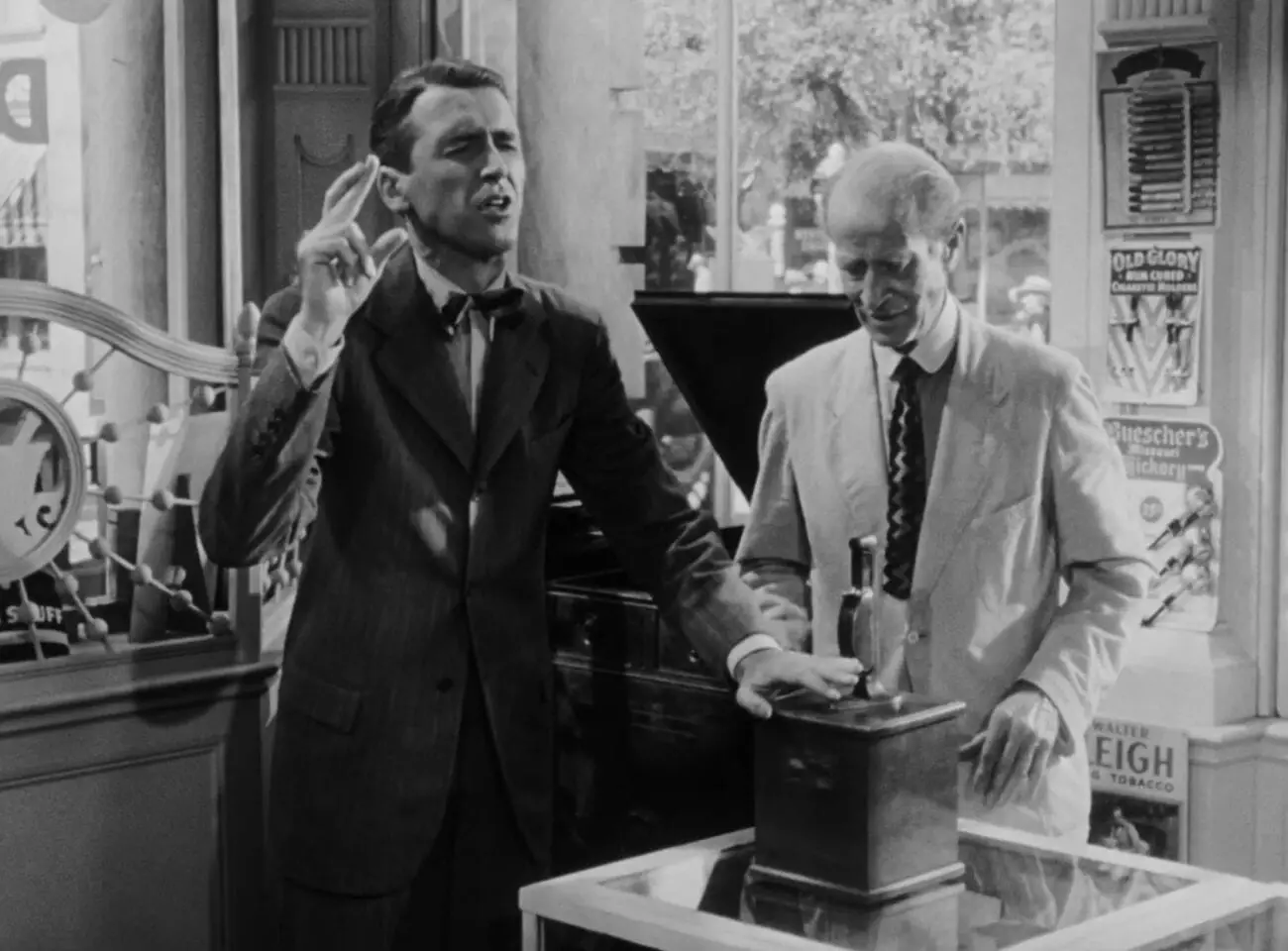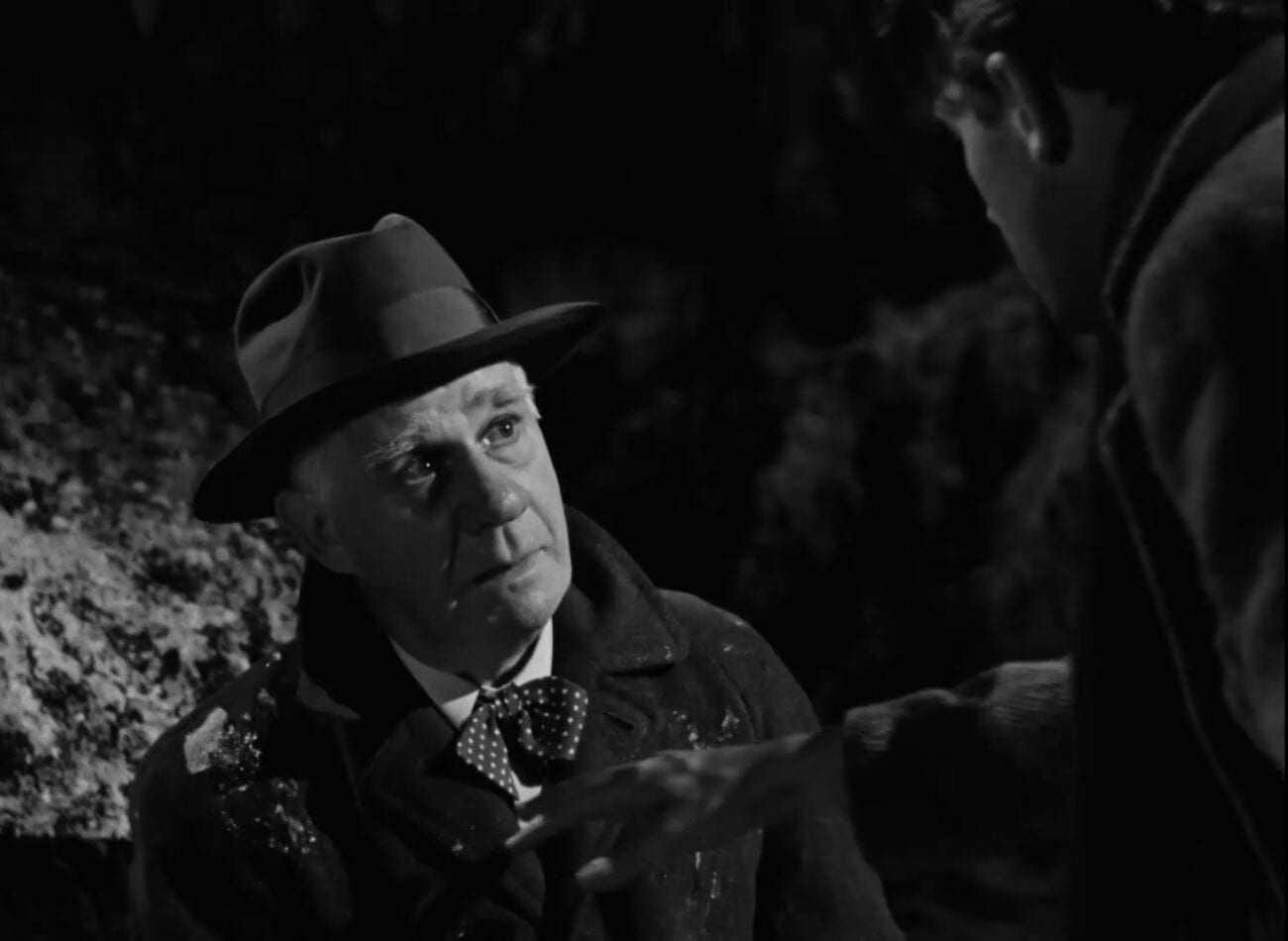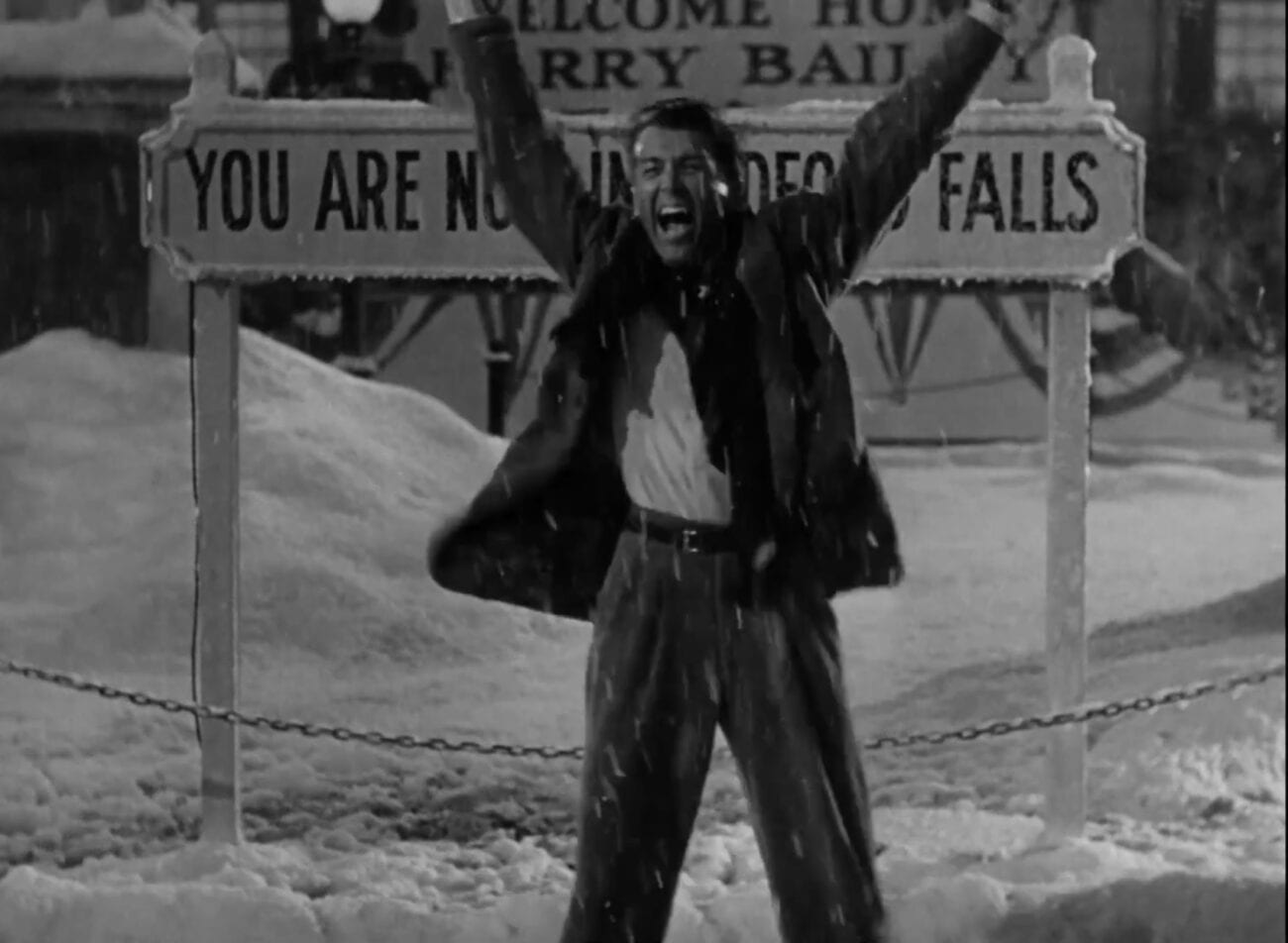On a summer night in 2011—hotter than anything out—I sat my two friends Katie and Tank down in Tank’s mother’s basement with one objective in mind. There was a film they both needed to see, immediately. A film that, to my recollection, I had harped on and on about all that day. My two friends obliged my seemingly crazed insistence. And so, in the cool of that finished basement, with thick blankets of humidity and mosquitos in equal measure smothering everything just outside the back door, I showed Katie and Tank It’s A Wonderful Life.
With the holiday season in the rearview mirror once more, it’s my educated guess, dear sisters and brothers, that at least some of you tuned to Frank Capra’s 1946 classic this year. NBC’s annual broadcast on Christmas Eve has developed over the decades into something of a tradition in households across America, usually viewed with casual eyes from the dinner table, or glanced at over a mountain of gift wrapping, all but forgotten until the eleventh hour. Yes, letting December 24th become December 26th without at least having a portion of It’s A Wonderful Life grace the old boob-tube is considered sacrilege in some quarters.
But here’s the thing, friends, and I’m going to spell it out very plainly:
It’s A Wonderful Life is not simply a Christmas movie.
I’ll say it again for anyone in the back.
It’s a Wonderful Life is not simply a Christmas movie, and furthermore, categorizing it as such would be woefully antithetical to the entire point of the film; outright dismissal of it until next year—in these times—is a disservice to ourselves as people.
I know what you’re thinking. Who’s this quack and why’s he typing these radical things?
Quack I may be, just maybe, but wrong I am not.
For those who are unfamiliar with It’s A Wonderful Life, pause your reading of this article and go watch it (currently available on Amazon Prime or in your family’s old VHS collection in the closet under the steps)—then come back, of course! Everyone else familiar with the basic plot of the film but in need of a brief refresher, here we go.

Struggling businessman George Bailey (James Stewart) contemplates ending his life on Christmas Eve after things go hopelessly sideways earlier in the day for the Bailey Brother’s Building and Loan. An Angel-Second Class by the name of Clarence Oddbody (Henry Travers) is dispatched from heaven to stop George from going through with it.
PAUSE.
You mean to tell me that a holiday classic from the 1940s surrounds itself with a guy trying to off himself on Christmas Eve? Isn’t that, I don’t know, a little dark?
Why, yes! Yes, it is. Forgot about that part, didn’t you? Sounds like a two hour and ten minute-long Twilight Zone episode when you think about it that way, doesn’t it?
Now, back to my abbreviated summary of the film.
Uh…wait…Two hours and ten minutes? It’s that long? Can’t all take place on one night, right?
Glad you brought that up. One hour and twelve minutes worth of the film takes place prior to George’s fateful night, at every other time of the year besides Christmas. In the frame of three celestial beings—Clarence included—discussing George’s life up until that point, we see George grow up from a wide eyed and ambitious boy into young adult, saddled with a family business he never had any interest in taking over. Once anchored in Bedford Falls, George falls in love with Mary Hatch (Donna Reed). The two have four children, move into the town’s biggest fixer-upper, and establish Bailey Park—an affordable housing development for Bedford Falls’ less fortunate souls—despite the exhaustive efforts of the nefarious, money-grubbing goon Mr. Potter (Lionel Barrymore).
As mentioned earlier, things go horribly awry for George on Christmas Eve when forgetful Uncle Billy (Thomas Mitchell) misplaces eight thousand dollars—incidentally handing it over to Mr. Potter in the blunder. Potter, being the warped and frustrated old man George Bailey identifies him as early on, keeps the Building and Loan’s money, rather than simply giving it back to Uncle Billy like any decent person would do. There’s some business with the bank examiner, and I’m not going to get into all that, assuming you’ve already seen the movie (if you haven’t, I told you before, go watch it and come back!), but what’s important is that George has to confront Mr. Potter and essentially beg this man—who has George’s friggin’ money, mind you—for a loan. The collateral? George’s life insurance policy, of course, and though it isn’t really explored fully, Potter saying “Why, you’re worth more dead than alive” leads George down to the damned bridge. That and, well, practically everything else in his life.
Now, let’s take a breath. We’re back at the steamy pile we met George wriggling in at the start. The rest of the story is more than likely what you’re most familiar with: Clarence shows George what Bedford Falls would be like if he were never born. Mary is an “old maid.” George’s mother is a bitter widow. George’s brother never survived falling into an icy pond when they were kids because, well, George wasn’t there to save him! Bailey Park? Doesn’t exist! It’s a cemetery! And Bedford Falls—without George around—has become Pottersville, a morally bankrupt cesspool of misery for one and all, big and small. Old Man Gower is a…
All right, you get the idea. Clarence sets everything right again once George writhes around in the sour soup of his own making long enough to regret his wish of never existing. He sees how important even just his life—the one he felt he’d been living wrong the whole time—meant to every single person he knew. The happy ending we get in the film is the result of everyone who George has positively affected banding together and collecting up all the funds they can muster to bail out the Building and Loan.
Here’s where we can start with our deeper look at this whole magnificent thing, tie it into our marvelous modern times.

From the start, it’s clear George is unhappy with his life, with the life choices he’s made, and every step of the way we can see him chip a little more off his mountain of dreams. Relatable? I’d say so. If we really want to get down to the marrow of things, haven’t we all—in one way or another—lived out the life of George Bailey during this ugly s.o.b. of a year? From long-planned trips to aspirations of climbing a simple rung on the employment ladder, we’ve all put our goals and hopes and plans on hold, much like George did when his father died. He stayed in Bedford Falls, let his brother go off to school first instead, just to ensure that the Bailey Brothers Building and Loan wouldn’t be consolidated. Did you hear me? I said George Bailey stayed home for the sake of others! If that doesn’t tickle a few of your ivories, there’s a high probability you don’t have ivories to tickle.
It’s A Wonderful Life is an adaptation of the novelette The Greatest Gift written by Philip Van Doren Stern, an academic non-fiction author most known for educational works distributed to Allied soldiers during World War II. While a very good read, and certainly the skeletal lay out of the film that strapped muscle to said bones, the source material Capra built from is far more of a personal journey; a contemplative piece solely based on a banker seeing his little world without him in. It’s cloistered, micro in scale. As someone who hadn’t read the Stern’s novelette until recently, the lack of interpersonal connection in the short work of fiction simply acts to magnify the importance of the film version’s general theme:
“Each man’s life touches so many other lives. When he isn’t around he leaves such an awful hole, doesn’t he?”
It goes without saying that in the world we currently inhabit, remembering such a seemingly simple thing as that statement goes a long way. The concept of awful holes that people leave when they aren’t around is all around us, twofold. As a society, we’ve lost an unbearable amount of people to this pandemic, people who all connected to others in ways too plentiful to count. But, also, we can think of all the lives dedicated to essential work—truckers, postal workers, retail workers who ensure the things we need for survival stay on the shelves. In such a way, the message Clarence has in those words for George is, quite possibly, a more valuable lesson now than ever. We’ve learned quite quickly just how important everyone around us truly is, even if we hadn’t considered it that way before.

I must say, watching It’s A Wonderful Life for, oh, the past four years has hit a little differently than it did back in that aforementioned palatial summer of 2011. With the current political climate in mind, charges of neglect would be in order for yours truly if we didn’t explore Mr. Potter just a little bit.
Henry Potter is Capra’s response to the carpetbaggers born from bowels of the Great Depression; the greasy, slippery cons and tycoons who proliferated well into the 1940s and beyond, preying on the desperation of others unabashedly for profit and status. Despite It’s A Wonderful Life having been filmed in black and white, the shimmery sheen of Mr. Potter’s office seems to indicate to the audience that primarily everything therein is either made of gold or colored as such. Familiar? Even a seemingly golden skull can briefly be spotted on Potter’s desk during the scene in which he offers George Bailey a job in exchange for the closure of Bailey Brother’s Building and Loan. Pretty damn on the nose, yet subtle enough to be overlooked. There’s a discussion early on in the film in which Potter muses about the “rabble” populating Bedford Falls, people he sees as unworthy of a helping hand, carrying out their lives working menial jobs (essential jobs, if you please). Everyone is simply a paycheck to him, someone he can keep under his thumb in his slum apartments (the ones George and company toil to get folks out from). A cursory glance at a certain prominent businessman/public figure from our time’s resumé would reveal much the same sort of thuggery. What’s more, throughout the film’s runtime, if anyone isn’t directly in the service of Potter, they’re nothing, worthless. “Suckers,” Potter calls people who speak ill of him once George broaches the subject. Potter even, albeit chump change by today’s standards, refers to local bar owner Mr. Martini’s family as “garlic eaters” in a derogatory fashion, cutting the Martini’s down to a cultural stereotype. God, where have we heard that kind of crap before? Oh, that’s right, we do the backstroke through it every day on Twitter. Potterism, if you’ll allow me the phrase, is very much as big threat to us societally today as Capra’s vision of Pottersville sluiced up for viewers in 1946. Maybe more. The question is, will we have the nerve of George Bailey to stand up to it? To call it out when we see it? To value the least of us at all costs? One could only hope so.
Perhaps the most well-known quote from It’s A Wonderful Life is the following:
“No man is a failure who has friends.”
Sure, we can comfortably chock that line, presented in the form of a mystical Christmas card to George from Clarence in the film, as the perfect capper on George Bailey’s story. All of his friends, the citizens of Bedford Falls that he—in one way or another—helped enrich the lives of, came to his rescue financially after Uncle Billy’s bungled blunder. But again, leaving that sentiment in the Bailey living room by the Christmas tree for next year misses the quotes point.
If there’s something we’ve learned through the year now past, having friends is something of a precious commodity. Sure, we might not be able to see them in person (and shouldn’t, see George Bailey stays home for the greater good), but having people in our lives that we care about, that we can rely on and share our feelings with, is critical. Time and again we’ve remembered to reach out to people—friends we may have cooled things off with, or mere acquaintances—just to see how they’ve been doing throughout everything. A friendly call to someone who might be feeling incredibly isolated or lonesome, someone struggling with the loss of a job or, worse yet, a loved one, is more valuable than all the gold in Potter’s vault. Upon hearing that the $8,000 dollars was missing, George internalized everything, going to bat with Potter alone rather than reaching outward. We find out at the end that Mary reached out to all of George’s connections for him, spoke with everyone in town that he’d cared for when no one else would. It’s these connections we’ve all made, that we’ve sifted out through our years thus far wandering our earth, that truly make life wonderful. It is certainly one thing to see that example in a movie and hear that quote, to hear that no man is a failure who has friends, but it’s another entirely to put it into action. To remind others that they’ve succeeded at something very special—being dear to you.

As we go into 2021, the world seems to be just as much of a murky, lurid place as it has been for many months now, a far cry from the summer of 2011 when I showed It’s A Wonderful Life to Katie and Tank. We’ve been changed—a cloth forever bearing a dark splotch of ink. These are the times of all our lives that determine the type of people we really are, and going forward we will need the kind of healing and clarity of vision that Clarence provided George when he let him see the world without him in it. In an odd way, we have now seen this world without anyone else in it—everything from a distance, void of our usual routines and gathered rituals. Maybe this past year was the first time you watched the subject of this article without your family by your side? But you know what, that’s okay. We too will learn from all of this. Going forward, we will all charge down the streets of our towns lighter and brighter, relieved and happy to see people—any people—and cherish the times we spend with family and friends that, like George, we perhaps took for granted before or were discontent with.
As I said before, It’s A Wonderful Life is not just a Christmas movie—both literally and metaphorically.
Doesn’t sound like such a wacky statement now, does it?
Collectively, in a plethora of ways, we’ve all had our George Bailey moment on our private, snow-choked bridges. But it is the trip through the Pottersville that was 2020, a year like no other, that will make us realize forever more that it truly is a wonderful life.



You were going really good until the “Trump/Potter” analogy. At that point, your review dissolved into the kind of partisan nonsense that director Capra was always totally against. So you missed the point of the movie.